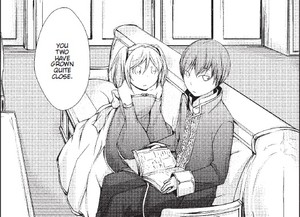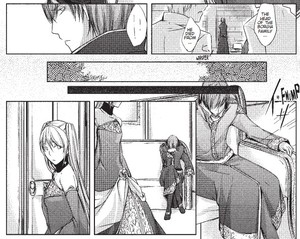The Fall 2024 Manga Guide
Hatsune Miku: Cantarella ~Poison of Blue~
What's It About?

A thrilling forbidden romance based on the VOCALOID song “Cantarella” featuring Hatsune Miku and KAITO!
Cesare, the eldest child of the notorious Borgia household in fifteenth-century Italy, learns he has a sister he's never met—Lucrezia. He is also given a poison called “Cantarella,” which has been handed down in the family for generations. The story unfolds after Cesare (here played by Kaito) meets Lucrezia (Hatsune Miku) for the first time…
Hatsune Miku: Cantarella ~Poison of Blue~ has a story by WhiteFlame and art by Ichika, with English translation by Angela Liu. This volume was lettered by Sean Bishop. Published by Seven Seas (September 10, 2024).
Is It Worth Reading?

Rebecca Silverman
Rating:
It would be foolish to go into a Vocaloid manga based on a song based on myths of Lucrezia and Cesare Borgia expecting historical fidelity, but what can I say? I'm a dreamer. Sadly, common sense ought to have won out on this one. Hatsune Miku: Cantarella is not the worst thing I've ever read, but it is one of the blandest, and given that it's about an incestuous relationship in a family of reputed poisoners, that's pretty damning. The single volume doesn't have the guts to lean into any of its interesting angles, leaving us with a book that may have a very limited appeal to Vocaloid completists and fans of the specific song.
The basic plot is easily summed up in about two sentences: Cesare Borgia meets his younger sister Lucrezia for the first time and falls for her. She's married off but in love with her brother, so uses a poison trick to get to live incestuously ever after with him. Parts of this are based on history – Lucrezia Borgia was married to Giovanni Sforza. The rest? Not so much, and frankly ideas of her as a lustful, incestuous poisoner are much more based on misogyny as a way to diminish a powerful woman than anything that really happened. It's hard to fault someone for taking a more poetic approach to the subject matter, but this feels like the barest nod to the real people involved and an excuse to see Kaito and Miku in vaguely historical costume.
I say “vaguely” because the only concession to the past is the length of the skirts and the use of tunics for men. Not that there's an obligation to be accurate, but this is so glaringly off, a weird blend of three centuries, that it's jarring. The rest of the art is simple to the point of being almost nondescript, though it isn't off-putting. Just a little bit dull, which is true of the entire book. Had it been given more room to develop, this actually could have been decent, but as it stands, the nicest thing I can say about it is that it at least didn't use that thrice-damned apocryphal poison ring.

Christopher Farris
Rating:
Some poisons kill quickly, while others do so slowly, like tortuously obvious critical metaphors. Hatsune Miku: Cantarella ~Poison of Blue~ theoretically has a lot to work with, being a manga adaptation of a Vocaloid song, itself based on the oft-retold tale of Lucrezia and Cesare Borgia as played by those musical manifestations of Skynet. It's sort of like those Muppet sketches with Kermit and Fozzie playing famous historical or literary characters, but with slightly more incest. It's at least worth an eyebrow-raise or two, but even with that adaptation turducken of a premise, it's astonishing how much nothing this manga packs into its page-count.
Obviously it's not like historical accuracy was ever a concern—that went out the window as soon as you cast Hatsune Miku as Lucrezia Borgia. But absent an attempt at period styling is any feeling of time or place at all for Cantarella. Cesare wanders halls that are styled like stock Unreal Engine castle assets that the designer hardly put any furniture or set dressing in. Occasionally there's a shot of a flower bed or a painting to break things up, but otherwise it's Cesare and Lucrezia vaguely orbiting each other through a period piece that takes place nowhere. It's not like the characters are carrying things, either. No worries if you're averse to incest, as there's no selling the taboo of such a royal romance without chemistry, and the singing automatons playing the leads might as well be actual machines in that regard. If you long for the thrill of watching a pair of iPods lying on a tile floor trying to court each other by playing Vocaloid songs at the lowest volume, well, this is the scintillating romance for you.
What can't be overstated is the sheer dullness with which Cantarella presents these already-lifeless components. The "story" of all this happening is essentially 130 pages of vague meandering buildup until arriving at the shrug of the"payoff" that is the final chapter. It's all connected by this book's most egregious issue: some of the most baffling paneling I've seen in a manga in a minute. Artist Ichika cannot stop scattering panels across the layouts, seemingly at random. It's just boxes and boxes of a few varying sizes slapped on top of some spreads with little regard for how they'll look, flow-wise. I guess I can appreciate a deep irony in something based on a song having no sense of tone or rhythm, but that's only a minor, momentary reprieve from what a slog this book is. Treat Cantarella like the poison it is, Vocaloid fans.
discuss this in the forum (25 posts) |
back to The Fall 2024 Manga Guide
Seasonal homepage / archives